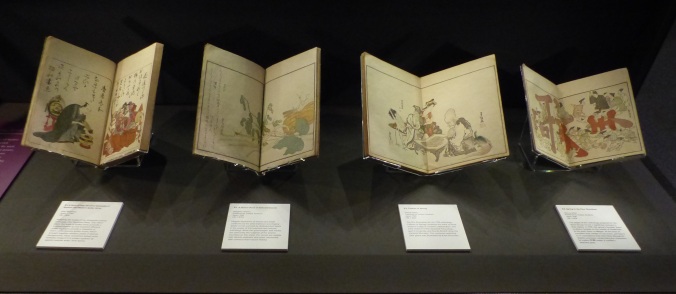The Chester Beatty Library’s collection of surimono and picture calendars extends to some 375 single sheet prints. Alongside these are the kyōka books and a further 116 surimono with illustrations in the Shijō style popular in Osaka and Kyoto, many of which are preserved in albums. The greater part of this collection was formed between 1954 and 1963.
Acquired by Sir Alfred Chester Beatty for his newly built Library in Dublin, the collection took shape under the specialist guidance of Jack Hillier and Beatty’s own developing interests in Japan’s printed arts. As works created through the collaboration of artists and poets in celebration of new beginnings, it is fitting that these prints were collected in that same spirit.

J 2183 before (above) and after conservation (below)
2017 marks the 60th anniversary of diplomatic relations between Japan and Ireland: an event precipitated in March 1957 by an exchange of letters between the Japanese and Irish ambassadors in London. The Chester Beatty Library is marking this anniversary with a special exhibition The Art of Friendship: Japanese Surimono Prints (March 3 – August 27 2017). Dr Mary Redfern, curator of East Asian collections, selected 95 single surimono prints for exhibition and a number of poetry anthologies and surimono albums all from the Library’s own collections and many by leading artists such as Hokusai and Gakutei. This new exhibition focuses on the surimono and the literati circles that created them.
The Library received a generous grant from the American Friends of the Arts in Ireland (AFAI) which enabled the Chester Beatty Library to conserve, mount and frame all the prints and related material currently on display.

The overall condition of the surimono collection is very good. The prints were all carefully mounted when the Library received funding for a conservator to travel to Dublin from Tokyo to advise and oversee the project. The mount card used nearly 40 years ago was conservation quality but quite thin and lightweight, so offered little support during handling and would not have prevented the prints touching the glass when framed for exhibition. The window apertures had been cut without a bevel, and overlapped the edges of the prints, hiding precious details of the images from scholars and visitors. The decision was therefore made to remove them from their historic mounts, and transfer them to new standard size mounts made from heavier (1650 micron) acid-free, buffered Conservation Board.

J 2171 Before (left) and after conservation (right)
The prints had been attached to the previous mounts with conservation standard handmade Japanese paper tabs, so these were gently lifted from the backboards and retained where possible. Each print was then gently surface cleaned using soft brushes.

Removing J 2171 from its old mount, and gently surface cleaning.
The prints were then carefully measured and in order to fully reveal the detail of the surimono, the new bevelled-edge apertures were cut slightly larger than each object so that the entire print could be seen. In order to mount the prints in this way, additional Japanese paper tabs were attached to the bottom edge of each print with wheat starch paste. These additional tabs along the bottom edge allow the prints to ‘float’ in the aperture, whilst the tabs hold them safely in place under the bevelled window.

Applying new tabs to the tail edge of J 2171
The surimono were then carefully positioned in their new mounts, and the uppermost Japanese paper tabs were secured to the backboard, again using wheat starch paste and dried under weights.

Mounting J 2171
New mahogany-coloured frames were ordered and each print selected for exhibition was framed by the team. Bespoke archival boxes have been ordered to house the collection while in long-term storage.

Mounting and framing the conserved surimono prints in the lab.
The seven bound volumes to be included in the exhibition were all in good condition. They were surface cleaned and minor tear repairs carried out where necessary. Bespoke acrylic cradles were made to exactly fit the opening of each volume. These were then installed in three display cases in the Library’s Temporary exhibition Gallery.

Four bound volumes on display.
Finally, the framed prints were hung in the gallery ready for the opening on 3rd March. Thanks to the generous grant provided by the American Friends of the Arts in Ireland, the Chester Beatty Library has been able to ensure the long-term preservation of this rare and beautiful collection.
Thanks to the generous grant provided by the American Friends of the Arts in Ireland, the Chester Beatty Library has been able to ensure the long-term preservation of this rare and beautiful collection.
The Art of Friendship: Japanese Surimono Prints runs from March 3 until August 27, 2017. We hope you’ll have the chance to visit the exhibition over the holidays.
Reblogged this on Zahra's Blog.
LikeLike
What a wonderful exhibition, well done to everyone involved.
LikeLike
Pingback: Reflections on links between Conservation in Dublin and Tokyo | Chester Beatty Conservation
Pingback: Summer at the Chester Beatty | Chester Beatty Conservation
Pingback: Seductive Marvels of Japanese Art– Materials and Techniques of Surimono Prints | Chester Beatty Conservation